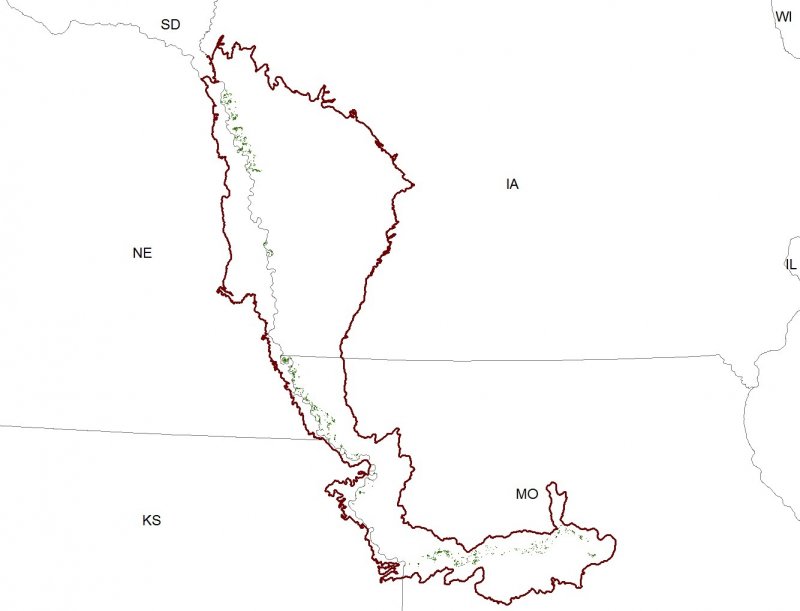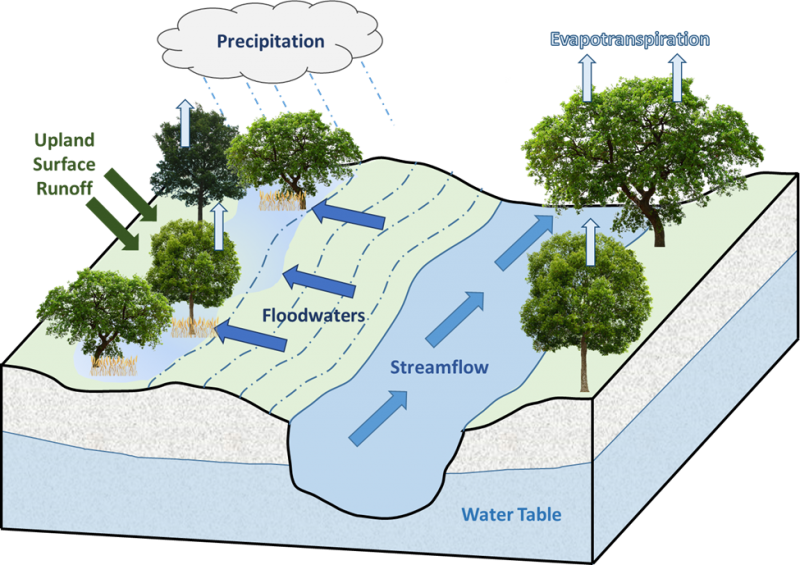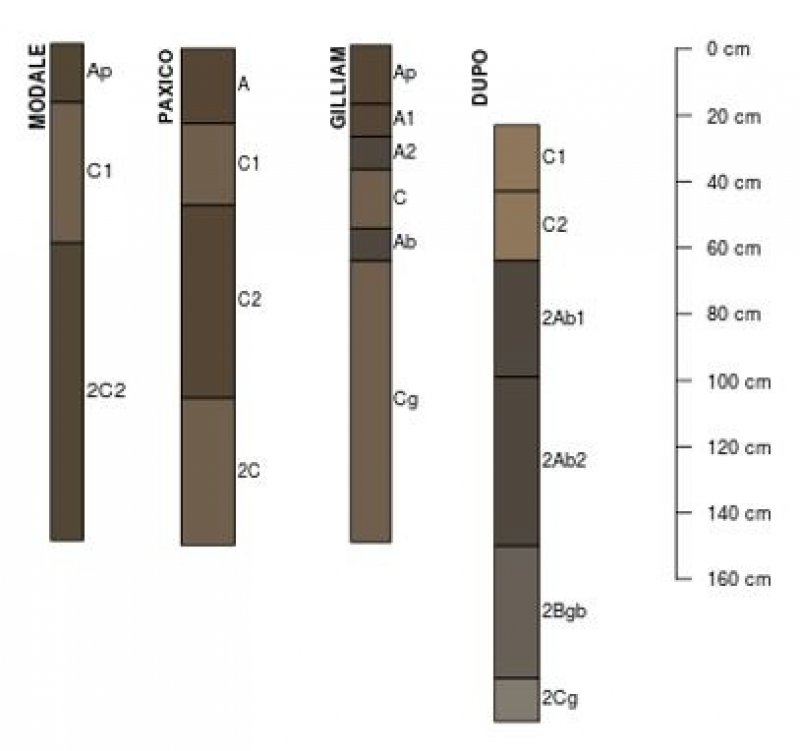Ecological dynamics
The Loess Hills region lies within the transition zone between the eastern deciduous forests and the Great Plains, with the Missouri River flowing through the middle. The heterogeneous topography of the area results in variable microclimates and fuel matrices that in turn are able to support prairies, savannas, woodlands, and forests (Nelson 2010). Wet Floodplain Woodlands form an aspect of this vegetative continuum. This ecological site occurs in floodplains less subject to flooding on somewhat poorly-drained alluvial soils. Species characteristic of this ecological site consist of upland and hydrophytic woody and herbaceous species (Nelson 2010; Steinauer and Rolfsmeier 2010).
Flooding is the dominant disturbance factor in Wet Floodplain Woodlands. Within MLRA 107B, seasonal flooding of shallow depths (less than 24 inches) occurs on an irregular basis, with surface water or soil saturation lasting for brief periods (two to fifteen percent) of the growing season. Sites are typically saturated in fall, winter, and spring (Nelson 2010).
Infrequent fires, windthrow events, and insect and disease outbreaks influence this site to a lesser, more localized extent (LANDFIRE 2009; Nelson 2010). Immediate responses to these events can alter forest structure and species richness or eveness, thereby impacting species diversity. Composition can also shift to one containing more early-successional species (Peterson 2000).
Today, many original Wet Floodplain Woodlands have been reduced as a result of drainage and clearing for agriculture, livestock, and urban development. Sites have also been degraded by stream channelization and levee construction which alters the hydrologic flood cycles and, ultimately, the reference plant community. Overgrazing by unnaturally high white-tailed deer populations also contributes to plant community changes, especially the reduction of ground flora and shrubs. Invasive species, such as garlic mustard (Alliaria petiolata L.), Japanese hops (Humulus japonicus Siebold & Zucc.), multiflora rose (Rosa multiflora Thunb.), common buckthorn (Rhamnus cathartica L.), and honeysuckle (Lonicera maackii (Rupr.) Herder, Lonicera tatarica L.) have been invading this site and reducing native species diversity (Nelson 2010; Steinauer and Rolfsmeier 2010).
State 1
Reference State
The reference plant community is categorized as a wet-mesic bottomland oak woodland. The two community phases within the reference state are dependent on seasonal flooding regimes and infrequent fires. The amount of water occurring at flood stages and fire intensity affects species composition, cover, and extent. Windthrow events and pest outbreaks have more localized impacts in the reference phases, but do contribute to overall plant community composition, diversity, cover, and productivity.
Community 1.1
Bur Oak – American Sycamore/Black Walnut – Elm/Virginia Wildrye – Wingstem
Sites in this reference community phase represent a bottomland oak woodland evolving out of shallow seasonal flooding (less than two feet) and infrequent fire (Nelson 2010). Bur oak and American sycamore are the dominant tree species for this reference community phase, while black walnut, common hackberry (Celtis occidentalis L.), slippery elm, and American elm are closely associated sub-canopy species (Rolfsmeier 2007; Nelson 2010; Steinauer and Rolfsmeier 2010). Tree heights range between 90 and 140 feet tall, tree size class is very large (>33-inches DBH), and the canopy coverage is between 40 and 67 percent (Rolfsmeier 2007; LANDFIRE 2009; Nelson 2010). The understory is dense and multilayered. The shrub layer is very scattered, populated with wild plum and coralberry. Numerous sedges and forbs form the herbaceous ground layer, including Virginia wildrye (Elymus virginicus L.) and wingstem (Nelson 2010; Steinauer and Rolfsmeier 2010).
Community 1.2
Bur Oak – American Sycamore/Black Walnut – Elm/Wild Plum – Coralberry/Sedges – Wingstem
This reference community phase can occur following a prolonged disturbance-free period. The canopy and subcanopy are similar in composition but cover increases to greater than 67 percent (Rolfsmeier 2007). Wild plum and coralberry become a more significant component of the vegetative community due to lack of disturbances, and shade-tolerant species begin to become a more prominent component of the herbaceous layer (Rolfsmeier 2007; Steinauer and Rolfsmeier 2010).
Pathway P1.1A
Community 1.1 to 1.2
Natural succession as a result of a prolonged, flood and/or fire-free period.
Pathway P1.2A
Community 1.2 to 1.1
Natural succession as a result of a recent flood or fire event.
State 2
Over-browsed Forest State
Overbrowsing by an unnaturally abundant white-tailed deer population (in addition to fire suppression and altered landscape hydrology) can transition the reference state into an over-browsed forest state. Continuous browsing has been reported to prevent the regeneration of the historic dominant canopy, which is replaced by mid-level and invasive species (Rolfsmeier 2007; Gubanyi et al. 2008; VerCauteren and Hygnstrom 2011). Common hackberry has a greater tolerance to deer browsing thus allowing it to dominate the tree canopy under high deer browse conditions. Similarly, as small woody shrubs and plants are continuously browsed, the gaps are replaced by less palatable herbaceous species (Gubanyi et al. 2008).
Community 2.1
Bur Oak – Common Hackberry/Slippery Elm/Missouri Gooseberry/Virginia Wildrye – Stinging Nettle
This community phase represents the initial impacts of browsing from an over-abundant deer population. The overstory component is out of browsing range from the deer and will persist. However, recruitment of these species becomes nonexistent as seedlings and small saplings are browsed. Common hackberry (Celtis occidentalis L.) is tolerant of deer browsing and can quickly become a co-dominant canopy species (Coladonato 1992; Rolsfmeier 2007; Gucker 2011). Wild plum and coralberry are preferred browse by deer and as they are reduced in the shrub canopy, Missouri gooseberry (Ribes missouriense Nutt.) becomes the dominant species (Rolfsmeier 2007; Steinauer and Rolfsmeier 2010). The herbaceous layer diversity is reduced, and disturbance-tolerant species, such as Virginia wildrye and stinging nettle remain (Urtica dioica L.).
Community 2.2
Bur Oak – Common Hackberry/Honeylocust – Black Walnut/Multiflora Rose/Garlic Mustard
As deer browsing continues unabated, the elms are replaced by honeylocust (Gleditsia triacanthos L.) and black walnut in the subcanopy (Rolfsmeier 2007). Non-native invasive species can become established and include multiflora rose and invasive garlic mustard (Gubanyi et al. 2008; Rawbinski 2008; Steinauer and Rolfsmeier 2010). In addition to continued disturbance from the overabundant deer, garlic mustard can also suppress the re-establishment of native species as it is known to produce an antifungal chemical that disrupts beneficial mychorrhizal fungi relationships (Stinson et al. 2006).
Pathway P2.1A
Community 2.1 to 2.2
Deer populations continue to rise and browsing rates increase.
Pathway P2.2A
Community 2.2 to 2.1
Deer populations are reduced or browse protection around vegetation less than two meters in height is installed.
State 3
Cool Season Pasture State
The cool-season pasture state occurs when the reference state has been anthropogenically altered for livestock production. Early settlers harvested the trees for timber and fuel and seeded such non-native cool-season species as Kentucky bluegrass (Poa pratensis L.), converting the woodland to pasture (Smith 1998). Over time, as lands were continually grazed by large herds of cattle, the non-native species were able to spread and expand across the site, reducing the native species diversity.
Community 3.1
Reed Canarygrass – Kentucky Bluegrass
Sites in this community phase arise from selective tree removal and seeding of non-native cool-season grasses (Steinauer and Rolfsmeier 2010). Oak, elm, sycamore, and hackberry all have some timber value and were harvested to supply the timber market for early settlers. Tree regeneration may occur for some time, but livestock can trample and eat tree seedlings thereby reducing the overstory. Unpalatable woody species, such as common pricklyash (Zanthoxylum americanum Mill.) and multiflora rose (Rosa multiflora Thunb.), can invade under excessive grazing (Randall and Herring 2012). Reed canarygrass (Phalaris arundinacea L.) and Kentucky bluegrass were common species used for pasture planting.
State 4
Cropland State
The Midwest is well-known for its highly-productive agricultural soils, and as a result, much of the MLRA has been converted to cropland, including portions of this ecological site. The continuous use of tillage, row-crop planting, and chemicals (i.e., herbicides, fertilizers, etc.) have effectively eliminated the reference community and many of its natural ecological functions in favor of crop production. Corn (Zea mays L.) and soybeans (Glycine max (L.) Merr.) are the dominant crops for the site. These areas are likely to remain in crop production for the foreseeable future.
Community 4.1
Conventional Tillage Field
Sites in this community phase typically consist of monoculture row-cropping maintained by conventional tillage practices. They are cropped in either continuous corn or corn-soybean rotations. The frequent use of deep tillage, low crop diversity, and bare soil conditions during the non-growing season negatively impact soil health. Under these practices, soil aggregation is reduced or destroyed, soil organic matter is reduced, erosion and runoff are increased, and infiltration is decreased, which can ultimately lead to undesirable changes in the hydrology of the watershed (Tomer et al. 2005).
Community 4.2
Conservation Tillage Field
This community phase is characterized by rotational crop production that utilizes various conservation tillage methods to promote soil health and reduce erosion. Conservation tillage methods include strip-till, ridge-till, vertical-till, or no-till planting systems. Strip-till keeps seedbed preparation to narrow bands less than one-third the width of the row where crop residue and soil consolidation are left undisturbed in-between seedbed areas. Strip-till planting may be completed in the fall and nutrient application either occurs simultaneously or at the time of planting. Ridge-till uses specialized equipment to create ridges in the seedbed and vegetative residue is left on the surface in between the ridges. Weeds are controlled with herbicides and/or cultivation, seedbed ridges are rebuilt during cultivation, and soils are left undisturbed from harvest to planting. Vertical-till systems employ machinery that lightly tills the soil and cuts up crop residue, mixing some of the residue into the top few inches of the soil while leaving a large portion on the surface. No-till management is the most conservative, disturbing soils only at the time of planting and fertilizer application. Compared to conventional tillage system, conservation tillage methods can reduce soil erosion, increase organic matter and water availability, improve water quality, and reduce soil compaction.
Community 4.3
Conservation Tillage Field/Alternative Crop Field
This condition applies conservation tillage methods as described above as well as adds cover crop practices. Cover crops typically include nitrogen-fixing species (e.g., legumes), small grains (e.g., rye, wheat, oats), or forage covers (e.g., turnips, radishes, rapeseed). The addition of cover crops not only adds plant diversity but also promotes soil health by reducing soil erosion, limiting nitrogen leaching, suppressing weeds, increasing soil organic matter, and improving the overall soil. In the case of small grain cover crops, surface cover and water infiltration are increased, while forage covers can be used to graze livestock or support local wildlife. Of the three community phases for this state, this phase promotes the greatest soil sustainability and improves ecological functioning within a cropland system.
Pathway P4.1A
Community 4.1 to 4.2
Tillage operations are greatly reduced, crop rotation occurs on a regular schedule, and crop residue is allowed to remain on the soil surface.
Pathway P4.1B
Community 4.1 to 4.3
Tillage operations are greatly reduced or eliminated, crop rotation is either reduced or eliminated, and crop residue is allowed to remain on the soil surface, and cover crops are implemented to prevent soil erosion.
Pathway P4.2A
Community 4.2 to 4.1
– Intensive tillage is utilized and monoculture row-cropping is established.
Pathway P4.2B
Community 4.2 to 4.3
Cover crops are implemented to prevent soil erosion.
Pathway P4.3B
Community 4.3 to 4.1
Intensive tillage is utilized, cover crops practices are abandoned, monoculture row-cropping is established, and crop rotation is reduced or eliminated.
Pathway P4.3A
Community 4.3 to 4.2
Cover crop practices are abandoned.
State 5
Reconstructed Woodland State
The combination of natural and anthropogenic disturbances occurring today has resulted in a number of forest health issues, and restoration back to the historic reference condition is likely not possible. Woodlands and forests are being stressed by non-native diseases and pests, habitat fragmentation, permanent changes in watershed hydrology, and overabundant deer populations on top of naturally-occurring disturbances (severe weather and native pests) (Flickinger 2010; Heitmeyer et al. 2015). However, these habitats provide multiple ecosystem services including carbon sequestration; clean air and water; soil conservation; biodiversity support; wildlife habitat; timber, fiber, and fuel products; as well as a variety of cultural activities (e.g., hiking, camping, hunting) (Millennium Ecosystem Assessment 2005; Flickinger 2010). Therefore, conservation of forests and woodlands should still be pursued. Woodland reconstructions are an important tool for repairing natural ecological functioning and providing habitat protection for numerous species of Wet Floodplain Woodlands. Therefore ecological restoration should aim to aid the recovery of degraded, damaged, or destroyed ecosystems. A successful restoration will have the ability to structurally and functionally sustain itself, demonstrate resilience to the ranges of stress and disturbance, and create and maintain positive biotic and abiotic interactions (SER 2002). The reconstructed woodland state is the result of a long-term commitment involving a multi-step, adaptive management process.
Community 5.1
Early Successional Reconstructed Woodland
This community phase represents the early community assembly from woodland reconstruction. It is highly dependent on the current condition of the woodland based on past and current land management actions, invasive species, and proximity to land populated with non-native pests and diseases. Therefore, no two sites will have the same early successional composition. Technical forestry assistance should be sought to develop suitable stewardship management plans.
Community 5.2
Late Successional Reconstructed Woodland
Appropriately timed management practices (e.g., prescribed fire, hazardous fuels management, forest stand improvement, continuing integrated pest management) applied to the early successional community phase can help increase the stand maturity, pushing the site into a late successional community phase over time. A late successional reconstructed woodland will have an uneven-aged canopy and a well-developed understory.
Pathway P5.1A
Community 5.1 to 5.2
Application of stand improvement practices in line with a developed management plan.
Pathway P5.2A
Community 5.2 to 5.1
Reconstruction experiences a setback from extreme weather event or improper timing of management actions.
Transition T1A
State 1 to 2
Overbrowsing by white-tailed deer, fire-suppression, and altered hydrology transition this site to the over-browsed forest state (2).
Transition T1B
State 1 to 3
Woody species reduction, interseeding of non-native, cool-season grasses, and continuous grazing transition this site to the cool-season pasture state (3).
Transition T1C
State 1 to 4
Installation of drain tiles, tillage, seeding of agricultural crops, and non-selective herbicide transition this site to the cropland state (4).
Restoration pathway R2B
State 2 to 5
Site preparation, tree planting and/or thinning, and invasive species control transition this site to the reconstructed woodland state (5).
Transition T3A
State 3 to 4
Installation of drain tiles, tillage, seeding of agricultural crops, and non-selective herbicide transition this site to the cropland state (4).
Restoration pathway R3A
State 3 to 5
Site preparation, tree planting and/or thinning, and invasive species control transition this site to the reconstructed woodland state (5).
Restoration pathway T4A
State 4 to 3
Non-selective herbicide, seeding of non-native cool-season grasses, and continuous grazing transitions the site to the cool-season pasture state (3).
Restoration pathway R4A
State 4 to 5
Site preparation, tree planting and/or thinning, and invasive species control transition this site to the reconstructed woodland state (5).
Transition T5A
State 5 to 2
Over-browsing by unnaturally high populations of white-tailed deer transition this site to the over-browsed woodland state (2).
Restoration pathway T5B
State 5 to 3
Tree removal and interseeding non-native cool-season grasses transition this site to the cool-season pasture state (3).
Transition T5C
State 5 to 4
Tillage, seeding of agricultural crops, and non-selective herbicide transition this site to the cropland state (4).





